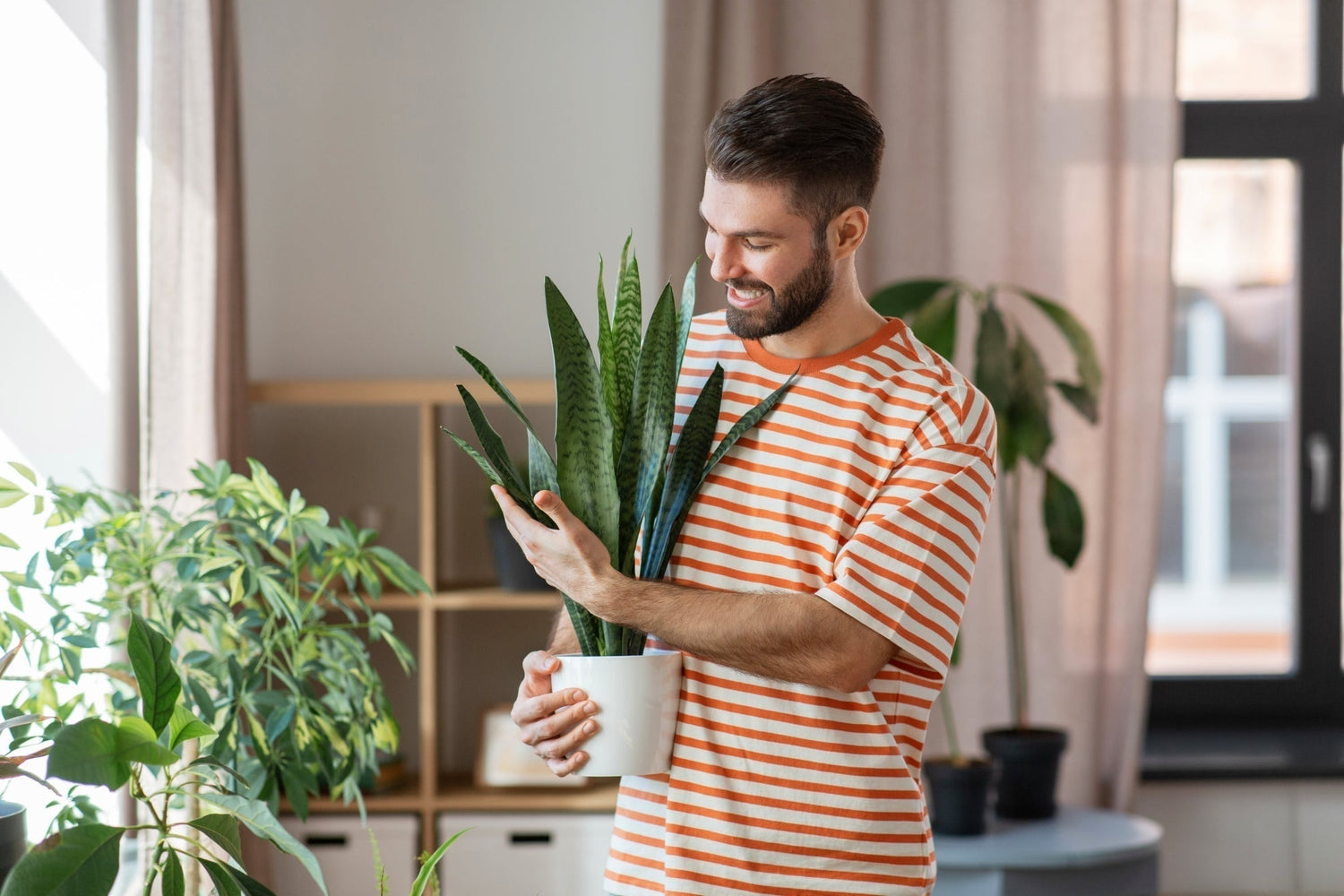Hey plant friends, let's have a real talk about the snake plant. You brought one home because everyone, from your grandma to that trendy plant influencer, swore it was the unkillable houseplant. And then... maybe you killed it. Or perhaps it's just... there. Not dying, but certainly not living its best life - looking a bit sad, a little floppy, and absolutely refusing to grow. If that sounds familiar, I feel you. I've been there. I was a self-proclaimed snake plant serial killer before I finally learned their language and became a true snake plant whisperer.
Here's the hard truth we all need to hear: "low-maintenance" is the most misunderstood and dangerously misleading term in the plant world. It does not mean "no maintenance." What it really means is "smart, minimal maintenance." These plants are incredibly resilient, but they have non-negotiable needs. Once you crack their simple code, they don't just survive in your home; they explode with vigorous, beautiful growth that will make you feel like a plant pro. I've compiled everything I learned the hard way, through trial and plenty of error, into this guide so you can skip the heartache and get straight to the thriving.
Myth #1: "They Love Low Light!" (The Biggest Lie in Plant Parenting)
We've all heard it, and it's the setup for almost every snake plant failure story. "It's perfect for that dark corner!" the tag says. So, you dutifully plop your new sansevieria in a dim spot, expecting it to be fine. And it will be... for a while. It won't throw a dramatic, yellow-leafed tantrum like a Calathea. It's more of a silent, stoic sufferer.
The most telling sign of light starvation isn't in the old leaves; it's in the new growth. When one of my plants was languishing in a "bright-ish" corner, the new leaves that emerged were long, floppy, and pale. They lacked the architectural stiffness they were famous for, often flopping over the side of the pot as if they had completely given up on life. On my beautiful yellow-edged 'Laurentii', the gorgeous variegation started to fade, with new growth coming in almost solid green. The plant was strategically ditching its fancy, energy-intensive patterns just to survive.
The turnaround came when I finally moved it to a sunny south-facing windowsill with a few hours of direct sun. Game. Changer. Within weeks, the new leaves coming in were fundamentally different - thicker, sturdier, and boasting a deep, rich green color. The contrast was insane.
The Bottom Line: Snake plants tolerate low light. They thrive in bright, even direct, light. That stretched-out, etiolated look? That's your plant desperately elongating its cells to reach for more photons. It's a clear sign of a light-starved plant. For a truly happy sansevieria, give it as much light as you possibly can. A south-facing window is a slice of heaven for them.
The Watering Tightrope: How Not to Drown Your Desert Friend

If there's one thing more likely to kill your snake plant than low light, it's our own watering habits. This was my biggest struggle for years. The frustrating paradox is that this plant can, and often does, die from both too much water AND too little water. It's the ultimate Goldilocks of the plant world - the amount has to be just right.
The Overwatering Crime Scene: First, let's remember what these plants are: succulents. Those thick, fleshy leaves are not just for show; they are built-in emergency water reservoirs. If you keep pouring water into an already full tank, the storage cells will eventually swell and burst. This turns the firm, succulent leaves into mushy, foul-smelling goo. If you've ever given a leaf a gentle squeeze and it felt soft and squishy, like an overripe tomato, you've just met the number one snake plant killer: root rot. I learned this lesson the hard way with my very first plant, which I killed with a rigid, "helpful" weekly watering schedule, never bothering to check the soil. It was a tragic, soggy end.
The Underwatering Illusion: In a panicked over-correction, many plant parents then swing too far the other way. You might see the leaves start to crease or fold in on themselves lengthwise, like a crispy taco. That is a classic sign of thirst. But here's the kicker that trips everyone up: if you give bone-dry, compacted soil just a tiny sip of water, the moisture will simply run down the dry, hard-packed sides of the pot and straight out the drainage hole, never even making contact with the vast majority of the roots.
The Goldilocks "Soak and Dry" Solution: So, how do you walk this tightrope? You master the "Soak and Dry" method. It's non-negotiable.
·The Soak: Only water when the soil is completely dry all the way through. To check, stick your finger deep into the soil, use a moisture meter, or a simple wooden chopstick. When it's dry, take the plant to the sink and give it a thorough, deep, and complete drenching. Pour water evenly over the soil until you see it running freely out of the bottom drainage hole.
·The Dry: Let the pot fully drain in the sink. Then, return it to its spot and walk away. Now, the most important part: you wait. Wait until the entire pot of soil has dried out completely again. This cycle might take one week in the summer or three or four weeks in the winter.
·The Right Setup: This method only works with the proper hardware. A pot with a drainage hole is NOT optional. Pair it with a gritty, well-draining succulent and cactus mix to prevent water retention.
Pot Size: Why Your Plant Wants to Be Snug
This is a mistake driven by good intentions. I used to look at my small snake plant and think, "A bigger pot means more room to grow, which means a bigger plant!" It seems logical, but it's utterly wrong. When I finally repotted my sansevieria into a pot that was far too large, it didn't grow; it just languished, became stressed, and was suddenly susceptible to the root rot we just talked about.
Why does this happen? An oversized pot holds a massive volume of soil, which in turn holds a large amount of moisture. The relatively small and compact root system of a snake plant simply can't absorb all that water quickly enough. This leaves the roots sitting in damp, airless soil for far too long, creating the perfect environment for root rot to set in.
Pro Tip: Snake plants actually prefer to be a bit root-bound. A snug pot encourages growth and helps prevent waterlogged soil. Only consider repotting when you see roots actively peeking out of the drainage holes or the plant is so pot-bound that it's physically starting to crack the plastic pot it's in. When you do repot, practice restraint. Only move up one pot size at a time (e.g., from a 4-inch pot to a 6-inch pot). This provides just enough new space without drowning the roots in soil.
The Grouping Hack for an Instant Lush Look

Did you buy a single, small snake plant pup and think it looked a little... lonely and sparse in its pot? The easiest and fastest way to get that full, lush, "statement" plant you see in interior design magazines is to group several small plants together in one single container! I did this about a year ago with three smaller plants from the nursery, and now the pot is gloriously full, dense, and even has a new pup trying to burst out over the edge. It's the most satisfying and affordable "designer" plant you'll ever create.
A few quick tips for grouping:
·Stick to the Potting Rules: Remember, don't over-pot them just because you have multiple plants. The "snug pot" rule still applies. Choose a pot that gives the root balls just a little room to grow.
·Watering Adjustments: With more plants drinking from the same amount of soil, the pot will dry out a bit faster. Keep a close eye on soil moisture after grouping.
·Light is Still Key: If you group multiple plants together in a dim spot, they will all etiolate together, creating a floppy, sad mess instead of a tight, architectural showcase.
The Final Word: Light is Everything
If you take away one single thing from this guide, let it be this: Stop treating your snake plant like a shade-loving creature. Start treating it like the sun-worshipping powerhouse it truly is. Maximize its light, master the soak-and-dry watering method, and keep it in an appropriately snug pot. It's a simple mindset shift from aiming for survival to celebrating explosive growth.
Naturally, we understand that every home has its challenging spots - that perfectly styled bookshelf or a modern bathroom that could use a touch of green but gets very little natural light. This is precisely the challenge we designed SANSI grow lights to solve. Unlike the harsh, purple glow of older technology, our lights feature a warm, natural spectrum that fits seamlessly into your living space. They provide the consistent, high-quality illumination your sansevieria needs to photosynthesize effectively, ensuring it remains compact, deeply colored, and healthy - no matter where you choose to place it in your home. It's our simple, elegant solution to bringing the power of sunshine indoors, empowering you to grow beautiful plants anywhere.


